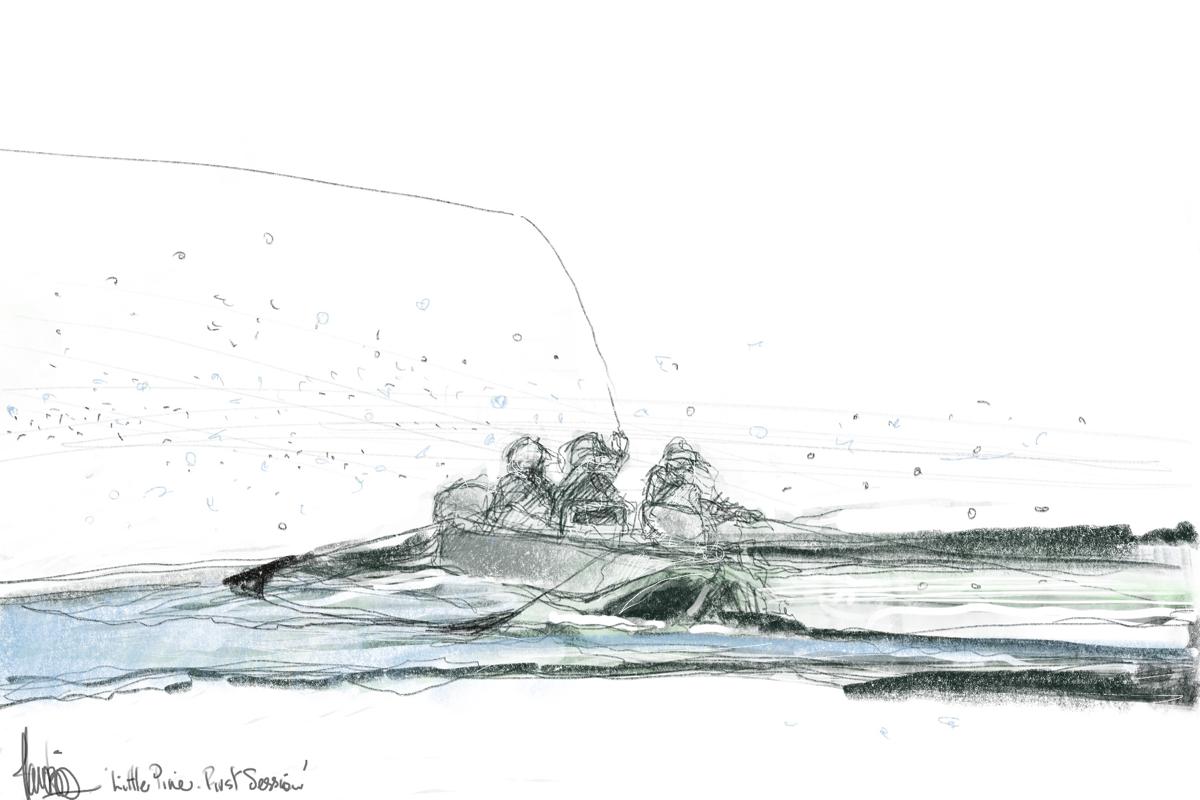
24 minute read
39th World Flyfishing Championships - Dan Factor
It gets very technical and the hatches only happen at certain times of the day. It’s very important to know when to change from a streamer to a wet and then to a dry fly and the Australians had really practiced and knew exactly when to switch.
With the conditions changing from a summer to arctic condition it levelled the playing fields for the international competitors. The fish weren’t where the Australians thought they would be and they were actually at a disadvantage because they kept on going back to what they knew. The international guys who didn’t know what to expect adapted to conditions a lot more quickly and this is evident in the results from sessions one, two and three.
Advertisement
Little Pine Lagoon is a big body of water that doesn’t have much cover and is completely exposed to the weather from all directions. It’s not a very deep lake with a maximum depth of four metres and because it’s so shallow it is full of weed. Most Tasmanian lakes aren’t deep at all
During preparation we expected a lot of wet fly fishing, stripping dabblers, snatchers and crunchers. They’re all medium mayfly imitations in sizes ten, twelve and fourteen that are fished under the surface. Where we found a hatch where we would change to a dry fly. With the conditions changing as they did we had to adapt our plans really quickly.
I was on the lake with an English team member, Tony Baldwin. We had a really good guide, Stewie Dickson, in our preparation and we had a very good idea of where to fish, but the sections of the lake to fish were really dependant on reading the wind on the day.
Especially in the start of a competition your first few drifts are the most important because the fish have gone for a couple of weeks without seeing an angler.

Litte Pine Lagoon- © Trevor Hawkins
You need to understand where the fish normally hang out and then work out where to put your boat to get a really good drift towards them. You don’t want to be in the best spot but where there’s four boats in front of you because then you’ll only get fourth shot at a piece of water.
I had captaincy first. I read the conditions and found a nice shallow bank that we could get a really long first drift down. I started off with a hover line (slow intermediate) and a dabbler on top and tried a few small streamers, just to cover water. The wind was blowing and it was freezing. This was to our detriment because we just weren’t used to it like the Europeans and the English were. I’d never seen anything like it.
I started off really well - actually both well and not very well - because my hands were frozen and I literally could not feel my fingers. I remember that on both the first and third casts I had fish on and I just couldn’t grab my line properly. I lost fish simply because my body was not used to the conditions. I tried everything. I had hand warmers with me and even used arctic fox gloves that I had bought in Tasmania but I just couldn’t warm up my hands.

Still, I got on the board pretty quickly with two or three fish really early and was up on my boat partner. I figured it out early; the fish were eating on the ‘hang’ but they weren’t deeper than ten centimetres below the surface. I kept three unweighted flies just under the surface and ‘hung’ really far away from the boat. My boat partner didn’t adapt and he wasn’t getting fish. I should’ve had a lot more fish and a better result but my hands wouldn’t work and I couldn’t hold onto the fish or place the net.
I managed a few good fish with the biggest being 527mm. My boat partner and I finished with four fish each. During his captaincy we went to a very quiet area where I had a really bad position in the boat and he managed to catch up. We finished sixth and seventh respectively.
It was a good start and I felt positive. In a world championship a top ten place in a session is having done really well, but another two fish would have placed me in the top three. I knew that I could have done better but that our preparation was on the ball.
Session 2, Sector One - Penstock Lagoon
Penstock is a lake that is stocked with both rainbows and browns. The browns stocking is not done from a hatchery. Fish from natural river systems or lakes with a good population of fish are moved to Penstock and other lakes in the area to boost their numbers. They’re still wildspawned brown trout.
Penstock Lagoon is quite a big lake but very shallow with an average depth of only one metre and not a lot of areas deeper than that. You can see the bottom the whole time as you fish. This lake is very well known for its massive mayfly hatches, so this was supposed to be a dry fly fishery, especially in summer. Every world championship until now has had two sessions per day, a morning and an afternoon session, but this tournament was reduced to one session a day so that everyone could benefit from the amazing mayfly hatches that happen during the Tasmanian summer. With the huge weather system that was just getting worse there weren’t many hatches. Once again we had snow, day temps of a couple of degrees Celsius and gale force winds. The beautiful mayfly fishery that we expected was nowhere to be seen.
I fished this lake with one of the Mongolian team. He didn’t know the lake very well so I took captaincy. I had pretty good intel from my team as to where the fish were holding court so we started just off the wall onto a weed bed. I was very fortunate to get into the fish very quickly.
I got some good fish with the biggest fish of my session being 507mm. It was a special session and I ended up with five fish
The beginning part of the session I found to be very good but we struggled a little bit toward the end. There was a hatch in the last half hour and we were able to covert a couple of fish on the dry. At the beginning of the session I fished a hover line with dabblers and streamers. Most of the fish were caught on the ‘hang’ and I still found that the fish were not deep - again just a couple of centimetres below the surface.
As the wind picked up everyone went for deeper and deeper lines so that they could get a long cast in. With the speed that the boat was moving because of the wind keep they were trying to keep up and not lose contact with the fly. I still found that shorter casts with the slow intermediate line just under the surface was a lot more effective. I always say that I’d rather fish in the column above the fish than below it, because trout fish look up. This is true especially in a lake like this where they tend to eat mayflies or dry flies and are always looking up no matter what. They’ll come up to eat a fly but a trout never looks down so it’s not going to move down to eat your fly.
In the last half an hour I converted a couple of fish on the dry fly. The Tasmanians use possum tail for all their dry fly material - no CDC or deer hair - and it’s actually a very nice material that I’m looking forward to playing around with in South Africa once I get the opportunity to.
We were starting to figure out what the fish were doing in the weather. There were no secret patterns and everyone was fishing more or less the same type of pattern. It was all about work rate and most importantly converting chances. If you got six or seven takes in your session and you landed all of them you would do really well. Guys who had takes but landed one fish ended up all the way at the bottom.
Session 3, Sector Two - Meander River
This is the most well known wild brown trout fishery in this area of Tasmania. We were fortunate that where the rivers are it is a lot warmer than the mountain ranges where the lakes are found. It was probably ten or twelve degrees with no snow or gale force winds.
The beats were extremely long with mine being just under a kilometre. This requires a huge strategic plan to fish them. I’d rather fish certain areas really well and really slowly then try rush and fish every piece of water in three hours. This is harder to say than it is to do.
I first walked my beat and it was beautiful. For the first five hundred metres I was able to walk along the river and see the water. After that there were three or four hundred metres of it that I couldn’t access and I had to climb a mountain (like a goat) and then come back down to see the top of the beat. There was a pool with a cliff that I couldn’t walk downstream of and then maybe sixty metres above it.

I found out that Lance Egan from the USA and a Spanish guy had fished my beat in the first two sessions. I knew that this water had been hammered and that for me to go through the same water as two top anglers and still get a top result was going to be very difficult.
When I walked the beat it took ten minutes to get over the mountain and I wasn’t sure what was between the water at the top and bottom of the beat. I made a bold decision and decided to start at the top of the beat. It was really, really nice pocket water and in my mind both anglers would have started at the bottom of the beat and would have not got to that top section - there’s way too much water and they wouldn’t have rushed it.
I spent an hour and forty five minutes in that top sixty metres of the beat and fished it slowly and methodically. If I saw a fish I spent time on it until I caught it. I caught six of my fish up there and enjoyed sight-fishing nymphs to them. There were not a lot of big fish and my biggest was thirty centimetres but it was a really special session.
After that I decided to go and try pick up a few fish at the beginning of the beat and I ran down. I did a lot of fitnesses training for this tournament but I can tell you that it’s not enough when you are nervous and while you run everything is flying everywhere. My heart was racing and I taught myself that if I ever get into that situation take a few minutes, redo a leader, relax and get my breath back, but all goes out the window when you’re fishing a
I rushed the first few minutes and I snapped off a fish and lost a fish. It wasn’t going well and I could’ve got an extra three or four fish - and probably won the session - if I just got my head in the right place. It took me ten or fifteen minutes to realise what I was doing and I took a deep breath and was able to pick up another few fish.
In the last three minutes I made a mistake that I preach to people not to make. I got to a section of water, saw a rising fish and with only a couple of minutes left instead of changing my rig and tying on a dry fly and catching it I threw my nymphs to it. The biggest mistake is to throw nymphs to a rising fish - you have a chance at catching him but more times than not you’re going to spook him or he’s not going to eat it because when they want to eat on the surface they eat on the surface, especially in a situation like we had in Tasmania where the weather wasn’t optimal for the trout.

I ended up with eighth place for the session and a forth place overall. I was stoked, especially competing against the Europeans on the rivers. For me it was a huge achievement and I was confident and looking forward to the session the following day.
Session 4, Sector Three - Woods Lake
Woods Lake is a monster, monster, ocean of a lake. This was probably the hardest of the competition because it’s so big and is so open that the wind that gusted between seventy and eighty miles per hour affected everyone. It was so bad that for two of the three first sessions they had to close most of the lake because it was too dangerous for boats to cross.
Our guide had given us information that there was a good nice shallow spot on the far side of the lake. I knew that nobody had being going there because the area had been closed. When we arrived that morning it was pretty flat - or not Titanic conditions - and we were told that the entire lake had been opened for the session.
I knew that the other teams had intel as to where fish had been caught in the first sessions and would head back to them. If the fish were in the shallow part, like we had been told, then it would be a great advantage to fish for them for the first time. It was risky because it was about a twenty minute ride on the boat to get there.
I again had a Mongolian boat partner and although he had captaincy he agreed to go where told him to go because I was doing well in the competition. He chose the front of the boat and while we were drifting that bank he would be casting tight to the bank.

better the fishing was but the less protected we were. Halfway through our drift we were flying off our seats. My bags were going overboard and it was a disaster. The skipper didn’t want us to stay there but I squeezed it and asked for one more cast, just one more cast, because I because that’s where the fish were.
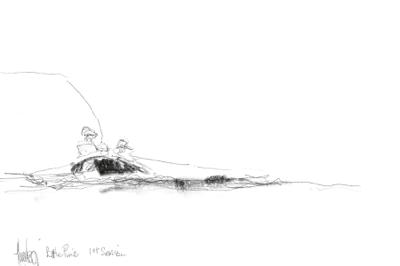
© Trevor Hawkins
It was a pretty successful first half of the session but my boat partner wasn’t landing his casts where they needed to be and I was frothing waiting for my chance to take my captaincy and get into a better casting position in the front of the boat.
The game plan was to cast into water that was two to five centimetres deep where the little wild browns sit and to pick them off the edges. I was keen to execute the plan but the boat driver looked at me and shook his head and said that it was dangerous. I told him that we were allowed to and that I wanted to give it a go.
Halfway through the ride to the other side the wind started to pick up. I looked behind me and it looked like D-Day. There were waves everywhere but luckily once we got through all of the messy water there was a tree line that protected the water that I wanted to fish.
We got into position and on the first cast near a tree stump I got my biggest fish of the session, a wild brown, at forty two centimetres. I started to fish the bank but it wasn’t as productive as I thought it would be, with only the odd take. We drifted four or five hundred metres and around a point and I took a fish. From then on it just got better and better along that bank.
Unfortunately the fish were really small so we lost a lot of fish. If I had to do that session again I’d probably fish a four weight with a floating line. I was fishing a six weight but a four would’ve kept those little fish on.
If you weren’t casting onto the bank you were casting nowhere. I knew where the fish were and I knew that he wasn’t getting all the way to them and was dropping a lot of fish.
When the captaincy changed I got my spot and was banging casts right onto the bank and it was very successful - I dropped a few fish but I got some. I ended the session with six fish and a fifth place. The winner, an Italian, landed seven fish. I was only a couple of centimetres off that first place. I was happy with the result and the momentum gained.
After the session I was eighth overall. That was a great achievement but it is obviously a huge team effort with team members communicating where the fish are and what’s working.

Once again there was nothing fancy. The fish were again really shallow and I was switching between a slow intermediate and a floating line and fishing really tight onto the bank with claret dabblers and small black streamers. The claret dabbler was definitely the fly. I enjoyed everything about the session except the boat ride back that was like a scene from The Perfect Storm.
Session 5, Sector Four - Mersey River
This was probably both the worst and the best session I’ve ever had. We knew that the top seven beats were terrible. That was just the way it was.
They were flat, laminar, shallow (several expletives redacted - editor) - horrible beats. Beats eight to twenty three were good with pocket water, riffles, cuts, heads and running water. We were lucky that our first four guys team members got the bottom beats but I woke up that morning knowing that I was eighth overall and had a good shot at getting a top three finish for
There were two busses to the river. One was for the top seven beats and the other for the remainder of the beats that were much further downriver. You are normally only given your beat when you get to the river but because of the transport issue they announced the names of the competitors fishing the top seven beats at the hotel and I was called up. I felt like my wife just divorced me or that someone had taken a spear and thrown it through my heart. I wasn’t happy and neither were some good anglers on the bus with me and we complained the whole way about how unfair it is - you know boys, we sulk
We arrived and I got given beat four, on paper the worst beat, and when I saw it I knew why. There was one piece of running water that was maybe a metre long and the rest was flat and dead. If a fish ever existed there I would’ve seen it from the bridge.

During the four previous sessions on that beat only one fish was caught. I wasn’t impressed but I decided to be positive, the draw was the draw, and that if I could catch one fish for the team it would be huge to be able to say that we didn’t blank there - especially in session five where the water has already been hammered by world class anglers over four consecutive days.
I decided to fish certain parts of the beat really well and not to rush it and try to fish everything. I fished less than a quarter of my beat in total. I started at the top of a pool - not the head because there was no real flow coming into it - where there was a deeper hole where I though a fish could be holding. I spent a lot of time fishing it methodically but I saw nothing and got nothing. stay positive.
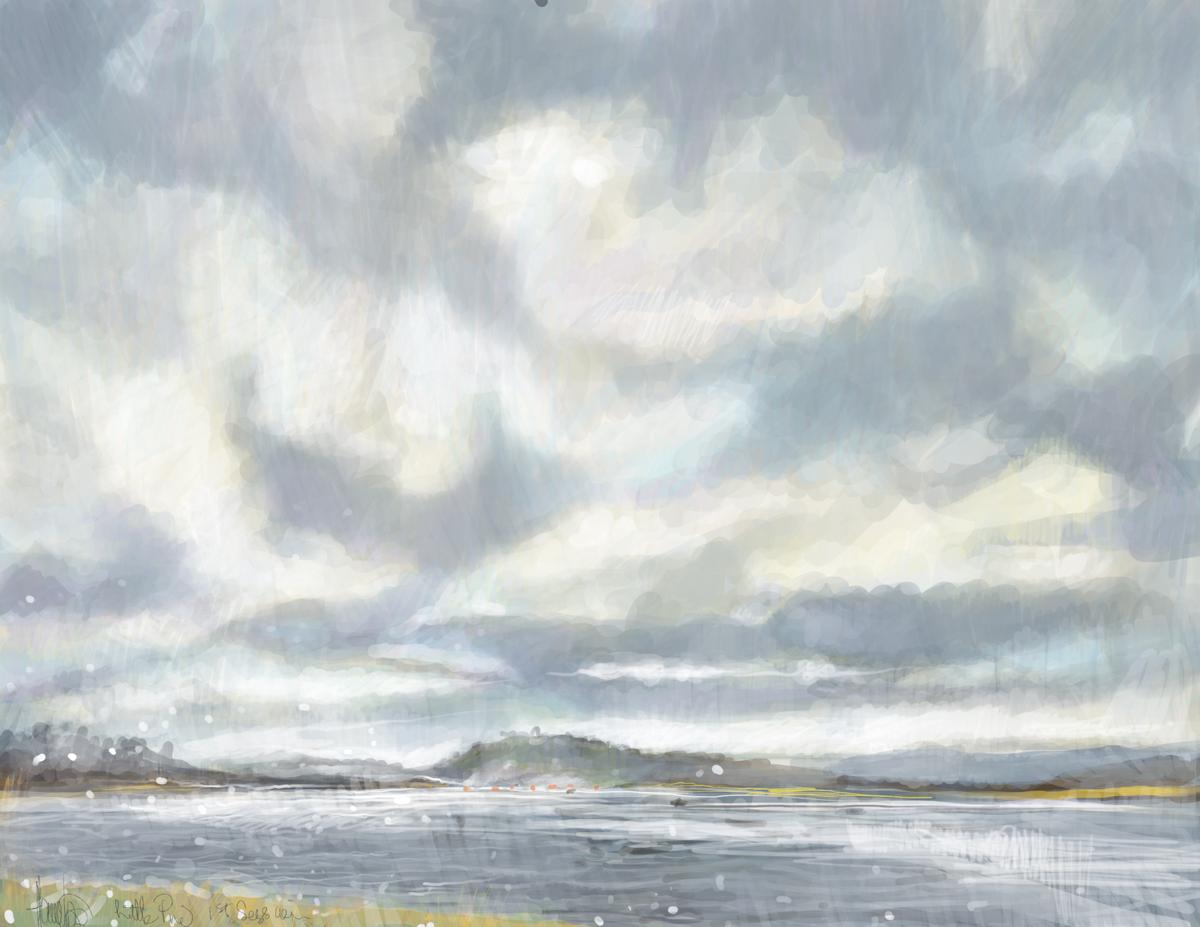
© Trevor Hawkins
Further up the river I crossed at a little island where on ether side there was very shallow water. There was very little flow on the right fork. On the left there was a little more flow and a deep hole. As media and camera crew arrived I thought that I probably had the worst situation ever in front of me. I stayed positive and felt like something was going to happen and I fished the hole. I hooked into Free Willy - ok, not that big but for the river and the situation it was a big fish. I was fishing 8X with a really small nymph and was trying to fish as slowly and as carefully as I could.
I wasn’t expecting a bigger fish because the average there was between twenty and thirty centimetres. As soon as I hooked it I ran straight into the hole because I knew that I couldn’t let any structure get between me and the fish.
These fish are extremely strong and it took me down river and I fought and controlled it for about ten minutes, trying to keep as calm as I could. I followed it down and landed it. When that fish landed in the net I screamed out of pure relief. I have never felt that good in my life. I’ve been fishing for most of my life and I’ve never had a fish that turned me emotionally like that fish did.
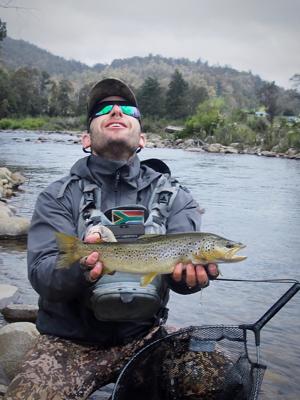
I was just screaming and the controller and the media crew were laughing and clapping and screaming and it was such an unbelievable moment. It was probably the hardest session of my life because of the fishing and situation I was in but that fish reminded me of exactly why I flyfish - it was just pure ecstasy and I’ve never felt like that before.It was the biggest fish of the session, a 440mm wild brown.
I felt so good that I hadn’t blanked and got a fish for myself and the team. I ran back, my whole tempo changed and a few casts later I got another fish, from the shallow water on the right of the island, but it was undersized.
A few minutes later I saw a fish move out of the shadow and back into the bank. I put Payette paste on my indicator and tied on a very small nymph. It came out and ate it and I landed it. At a little over 30cm I was onto two fish. I tried to fish the other water again but with two fish for the session I was happy. It was amazing and I have never felt so proud of a situation in my life.
I wasn’t expecting to place anywhere near the top half of the pack with only two fish but I was very surprised when I got back to find that there were a lot of twos, ones and blanks. I managed to place tenth for the session. I was positive but a bit disappointed at not being able to get a top five finish for the tournament.
I dropped from eighth to eleventh overall, for me a massive achievement, and my top finish in worlds as an individual. The team also finished eleventh. This is a great result for a team that is relatively inexperienced.
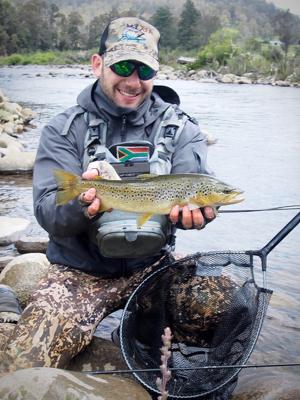
For Sale: 1.5 hectares in a Fish & Wildlife Reserve
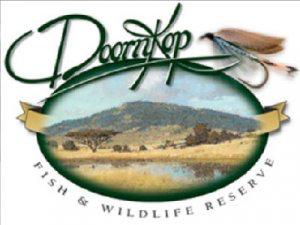

A prime stand situated in a well-known Fish & Wildlife estate close to Carolina and Machadodorp is for sale. The estate lies in the Komati Valley with both the Komati River and Swartwaterspruit running through it. There are 10 dams and 2 rivers with Trout, Bass, Yellow fish and Kurpers with a professional bailiff on hand. A huge range of wildlife - you can even go on your own night drive. Activities include Fishing, Hiking, Horse rides, Wildlife trails, 4 x 4 trails, Waterfalls. A clubhouse, hot pool, games room and a small shop are available. Very secure and relaxing with the majestic natural beauty of dams, rivers and mountains. Levy recovery easily achieved through holiday rental with the resort achieving high occupancy rates. Malaria-free area. This is the ideal opportunity to build your dream holiday home or even retirement home out in the country.
Contact : Elna Griffiths


+27 74 887 3429 or +27 13 253 0519 elna.griffiths@pamgolding.co.za
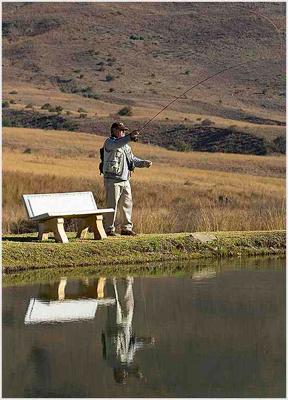

FOREL EN VLIEGHENGEL IN SUID AFRIKA
Gerhard Delport
Hengelaars in Suid Afrika geniet die sport van vlieghengel vir forel al vir meer as honderd en dertig jaar.
As vlieghengelaars is ons veel verskuldig aan die pioniers wat ten spyte van geweldige moeilike en hartroerende mislukkings nooit moed verloor het nie. Hulle het uiteindelik daarin geslaag om reenboog en bruin forel in die Wes Kaap, Oos Kaap en Kwazulu Natal te vestig.
Die eerste keer wat gepoog is om forelle na Suid Afrika in te voer was in 1875 deur beide 'n Natal en ’n Kaapse hengelaar. Die poging het egter misluk. Vroeg in 1880 het ’n groep hengelaars, wat daarvan oortuig was dat die skoon en koue waters van die bogenoemde provinsies wel geskik is vir forel, weer besluit om forel eiers in te voer.
Twee van die baanbrekers in die projek was Mnr John Parker van Yorkshire, ’n boer in die Howick distrik van Natal, en Mnr Lachlan Mclean, die algemene bestuurder, van die Union Castle-lyn in Kaapstad. Twee keer het hulle forel eiers uit Skotland ingevoer sonder sukses.
John Parker het in 1889 daarin geslaag om die destydse Natal se regering in sy skema te laat belangstel. Hy wou forel in die koue, skoon water van die Drakensberg vestig en die regeering het ’n allermintige vyf honderd pond bewillig. Teen die einde van 1889 is ’n besending met tien duisend Atlantiese Salm eiers, dertig duisend bruin forel eiers en tien duisend rooi forel eiers vanuit Skotland ontvang. Salm en Rooi forel was nie ’n sukses nie maar daar is sukses behaal met die Bruin forel en in 1891 is ses duisend klein vissies in die Mooi-, Boesmansen Umgenirivier geplaas.
Later is nog een honderd duisend eiers ingevoer waarvan drie duisend een honderd klein forel vingerlinge in 1891 in die Mooi-, Klein Mooi-, Klein Tugela-, Klip-, Umgeni-, Umlaas-, Yarrow-, Inyamvuma- en Illoworivier vry gelaat kon word.
Hulle het minstens twee keer salm eiers in gevoer maar daar is bevind dat salm nie geskik is vir Suid Afrikaanse waters nie. Die eksperiment met die rooi-forelle was ook nie suksesvol nie.
In 1892 is ’n derde besending van een honderd vyf en sewentig duisend eiers bestel maar meeste van die eiers het op die skip vergaan oppad Suid Afrika toe.
Teen 1893 is daar nog geen resultate gesien in die riviere waarin die forelle vry gelaat is nie en die Natalse regering het alle belangstelling in die forel projek verloor.
Daar is egter eers in 1896 bevind dat die Mooi-, Boesmans- en Umgenirivier 'n forel bevolking het. Die Natalse regering het ’n aktiewe rol begin speel en ’n visteelstasie is op John Parker se plaas “Tethorth” in die Howick distrik opgerig.
Forel hengelaars is baie aan John Parker verskuldig. Sy nagedagtinis word geeër op die landgoed van die wêreld beroemde “Trout Bungalow” geleë op die oewers van die Mooirivier in die Nottingham Road Distrik. Hier, in 1926, is ’n gedenksteen met










